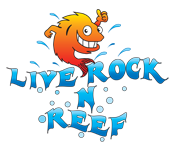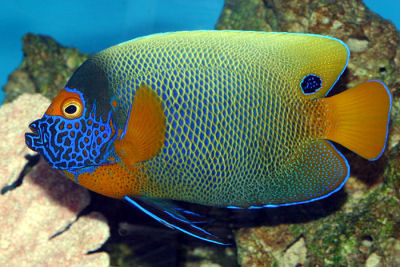Pomacanthus xanthometopon is known under several different names in English, including Blue-face Angelfish, Blue-faced Angelfish, Blueface Angelfish, Bluefaced Angelfish, Yellow-face Angelfish, Yellow-faced Angelfish, Yellowface Angelfish, Yellowfaced Angelfish, and Yellowmask Angelfish.
The Blueface Angelfish occurs in the Indo-Pacific,inhabits lagoon, channels and outer reef slopes with prolific algae growth. Juvenile specimens are typically found in shallow waters and are especially common in inshore caves with algae growth.
The juvenile fish is covered in vertical black, white and sapphire blue stripes. When it reaches a length of roughly 5 in / 13 cm, it will start changing into its adult coloration. The body develops a pale yellow shade bluish scales and the pectoral fin becomes bright yellow.
The face of the adult fish is mottled-blue with small yellow spots and a characteristic yellow mask extends from eye to eye (but not much beyond each eye). On the caudal end of the dorsal fin, you can see a black eyespot.
Recommended tank size:
Ideally, it should be provided with an established 90+ gallon aquarium setup with a live sand substrate (they enjoy snacking on benthic invertebrates) and plenty of live rock for grazing, shelter, and territory.
They should also have plenty of open swimming space and strong water movement in addition to high intensity lighting.
Reef Compatibility:
Will nip at sessile invertebrates such as nudibranchs, corals, and clams.
Food and Diet:
In the aquarium they should be sustained by a wide selection of live, fresh, or frozen and vitamin-enriched brine shrimp, mysis shrimp, chopped krill, chopped clams, chopped squid, marine algae, zucchini, spinach, romaine lettuce, and quality Spirulina-based flake foods for angelfish and herbivores.
Feed them at least three small meals a day to help support their fast metabolism.
If a specimen doesn't initially eat during acclimation, they can be enticed with live brine shrimp, ghost shrimp, and freshly chopped seafood.
Level of Care: Moderate
Approximate Purchase Size:
Small 2" to 3"; Medium 3" to 4"; Large: 4" to 6"


